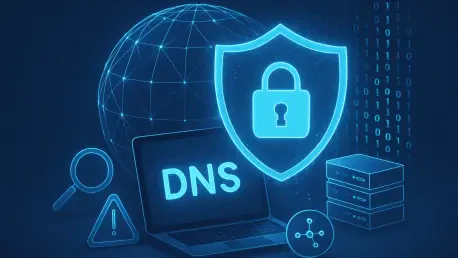In the ever-evolving world of cybersecurity, few areas are as critical yet often overlooked as DNS security. Today, we’re thrilled to sit down with Maryanne Baines, a renowned expert in cloud technology and digital infrastructure protection. With her extensive experience evaluating tech stacks and securing digital environments across industries, Maryanne offers unparalleled insights into how businesses can safeguard their operations from cyber threats exploiting the Domain Name System (DNS). In this conversation, we’ll explore the fundamentals of DNS and its vulnerabilities, delve into real-world attack methods like domain and subdomain hijacking, and uncover actionable strategies for businesses to bolster their defenses in an increasingly hostile digital landscape.
What is the Domain Name System, or DNS, and why should businesses pay close attention to it?
DNS is essentially the internet’s phonebook. It translates human-friendly domain names, like www.example.com, into IP addresses that computers use to locate websites, send emails, or enable other online services. For businesses, DNS is the foundation of their digital presence—without it, customers can’t access their websites, employees can’t communicate via email, and operations grind to a halt. It’s not just about connectivity; it’s about trust and reliability. If DNS is compromised, it can lead to devastating consequences like data breaches or loss of customer confidence, which is why securing it is non-negotiable in today’s threat landscape.
How do cybercriminals exploit DNS to carry out attacks like phishing or ransomware?
Cybercriminals are incredibly crafty when it comes to exploiting DNS. In phishing, they often create lookalike domains that mimic legitimate ones—think a slight misspelling like “g00gle.com” instead of “google.com”—to trick users into entering sensitive information like login credentials. With ransomware, attackers might use DNS to redirect traffic to malicious servers that infect devices with malware, locking up systems until a ransom is paid. DNS is a gateway for these attacks because it’s a trusted system most people don’t think twice about, making it an easy target for manipulation if proper safeguards aren’t in place.
Why do you think so many companies—72% according to recent data—have implemented fewer than half of the recommended DNS security measures?
There’s a mix of reasons, but a big one is the lack of visibility into DNS as a security concern. Many businesses focus on flashy cybersecurity tools like firewalls or endpoint protection, while DNS gets treated as a basic utility that just works. There’s also a resource issue—implementing robust DNS security often requires budget, expertise, and time, which smaller companies or those with stretched IT teams might not have. Lastly, there’s a gap in awareness at the leadership level; if executives don’t understand the risks tied to DNS, it’s hard to prioritize it over other pressing concerns.
Can you explain what domain hijacking is and how attackers typically pull it off?
Domain hijacking is when an attacker gains unauthorized control over a company’s domain by tampering with its DNS records. This often happens through weak credentials—think reused or simple passwords—that allow attackers to log into a domain registrar account. They might also use social engineering to trick a registrar into transferring ownership. Once they have control, they can redirect traffic to malicious sites, steal data, or even impersonate the business. It’s a silent but devastating attack because it can go unnoticed until significant damage is done.
What about subdomain hijacking? How does it pose a unique threat to well-known brands?
Subdomain hijacking targets forgotten or abandoned subdomains—think something like “promo.example.com” that was used for a one-time campaign and then left unsecured. Attackers can claim these subdomains if they’re not properly managed, using them to host malicious content or launch phishing attacks under the umbrella of a trusted brand. For well-known companies, this is especially dangerous because customers inherently trust their domain. A single breach through a subdomain can tarnish a brand’s reputation, making people question whether any interaction with the company is safe.
Drawing from high-profile incidents like the attack on Marks & Spencer’s domain by the ‘Scattered Spider’ group, what can other businesses learn from such breaches?
The key takeaway from incidents like that is the speed and scale of damage a DNS attack can cause. When a domain is compromised, it’s not just a technical issue—it directly impacts customer trust and revenue. Businesses need to learn that proactive defense is far cheaper than damage control. This means regularly auditing their digital assets, securing access to domain management tools, and preparing an incident response plan. It’s also a reminder that no company is too big to be targeted; attackers often go after high-profile brands precisely because of the potential payoff.
What are some practical steps businesses can take right now to start protecting their DNS infrastructure?
First, enable multifactor authentication (MFA) through your domain registrar—it adds a crucial layer of security by requiring a second form of verification beyond just a password. Next, use strong, unique passwords for all accounts tied to domain management; password managers can help with this. Another immediate step is to request a domain lock to prevent unauthorized transfers or changes. Beyond that, businesses should monitor DNS traffic for anything unusual and consider adopting protocols like DNSSEC, which verifies the authenticity of DNS queries to prevent spoofing. These steps aren’t complex, but they can make a huge difference.
How can companies effectively educate their employees about DNS-related threats and improve overall awareness?
Education starts with making the threat relatable. Companies should run regular training sessions that simulate real-world scenarios, like phishing emails using fake domains, so employees can learn to spot red flags. It’s also important to keep the message simple—teach staff to double-check URLs for misspellings or odd extensions and to never click links or share info without verifying the source. Creating a culture of vigilance, where employees feel empowered to report suspicious activity without fear of blame, is key. Regular updates on new attack trends can also keep everyone on their toes.
Looking ahead, what is your forecast for the future of DNS security and the evolving cyber threat landscape?
I think DNS security will become a much bigger focus in the coming years as cyberattacks grow more sophisticated. We’re already seeing attackers leverage automation and AI to identify vulnerabilities in DNS configurations at scale, so businesses will need to adopt more advanced, automated defense tools to keep up. At the same time, I expect regulatory bodies to step in with stricter guidelines around DNS protection, especially for industries handling sensitive data. My forecast is that companies who treat DNS security as an afterthought will face increasingly severe consequences, while those who invest now will build a competitive edge through trust and resilience.









